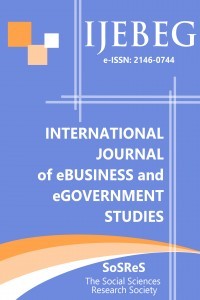CATCHING-UP AND LEADING IN E-GOVERNMENT: UNDERSTANDING KOREA’S EXPEREIENCE FROM THE COMPLEX PRODUCT SYSTEMS PERSPECTIVE
CATCHING-UP AND LEADING IN E-GOVERNMENT: UNDERSTANDING KOREA’S EXPEREIENCE FROM THE COMPLEX PRODUCT SYSTEMS PERSPECTIVE
e-government, complex product system Korea, and catch-up,
___
- Central IT Unit, Cabinet Office, United Kingdom(CITU)(2000), Electronic Service Delivery: Spring 2000 Report, London: CITU.
- OECD(2003), The E-Government Imperative, Paris: OECD Publication Service.
- OECD(2004), The E-Government Imperative, Paris: OECD Publication Service.
- OMB(2002), E-Government Strategy, DC: OMB
- Song, Heejoon(2006), E-Government in Developing Countires: Lessons learned from Republic of Korea, Bankok: UNESCO Bankok.
- United Nations & American Socierty for Public Administration(ASPA)(2002), Bench-marking E-government: A Global Perspective, New York: U.N. Peublications.
- Choung, Jaeyong, Hyeran Hwang and Heeseung Yang (2006), “The co-evolution of technology and institution in the Korean information and communications industry”, International Journal of Technology Management, Vol. 36, pp. 249–266.
- Davies, Andrew and Tim Brady (1998), “Policies for a complex product system”, Futures, Vol. 30, No. 4, pp.293–304.
- Gronlund, Ake. and Horan, A. Thomas (2005), “Introducing e-governmnet: History, definition and issues”, Communications of the Association for Information Systems, Vol.15(39), pp.713-729.
- Hobday, Mike (1998), “Product complexity, innovation and industrial organization”, Research Policy, Vol. 26, pp. 689-710.
- Kim, Dong-Wook(1996), “Efficient promotion plan for implementing e- government”, Journal of Korean Administration, Vol.34(2), pp.269-288 (in Korean).
- Lee, Young-Joo, Kang, Gyeong-Hee, Shin, Jae-Woo, and Lee, Joong-Jung (2010), “Analysis on Korean studies on E-government”, Informatization Policy, Vol. 16(3), pp36~56. (in Korean).
- Park, Tae-Young(2013), “How a latecomer succeeded in a complex product system industry: Three case studies in the Korean telecommunication systems”, Industrial and Corporate Change, Vol.22(2), pp.363-396.
- Song, Hee-Joon(2010), “Building e-government through reform: the Korean Experience”, Journal of E-Government, Vol.33, pp. 49-60.
- Başlangıç: 2009
- Yayıncı: Sosyal Bilimler Araştırmaları Derneği
MOVING TOWARD E-BUSINESS: CUSTOMER RELATIONSHIP MANAGEMENT ALIGNMENT IN MALAYSIAN SMALL BUSINESS
Norshidah MOHAMED, Murni MAHMUD, Abdul Rahman AHLAN, Ramlah HUSSEİN, Nor Shahriza Abdul KARİM, Umar Aditiawarman
KNOWLEDGE MANAGEMENT IN ACCOUNTING FOR FIRMS: BEST PRACTICES AND LEARNING LESSONS FOR KAZAKHSTAN
